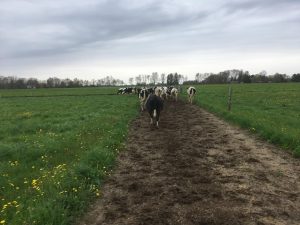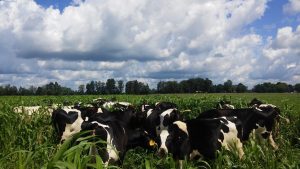Brook Wilke, Farm Manager at MSU’s W.K. Kellogg Biological Station, helps take the guesswork out of when cows should return to pasture. This blog was originally featured in the print edition of The Farmer’s Exchange.
~~~~~~~~~~~~~~~~~~~~~~~~~
One question that I get asked quite a bit, and often ask myself, is; when do I turn the cows out to pasture? I think this is a common question that all graziers wrestle with, and even if we have some hard and fast rules about how to approach the topic, there always seems to be some uncertainty. “Jumping the gun” can get you off to a really bad start to the year, yet waiting too long just makes managing the spring flush that much more challenging.
The first thought that comes to my mind is that I can let the cows out whenever I can finally get around to getting all of the fence fixed up. This is even a challenge for us at the MSU Pasture Dairy  Center every year. As we pass the spring equinox, our focus turns to calving, hauling manure, prepping fields for planting, and everything else that comes with spring. Fencing sometimes becomes an afterthought until it’s an absolute necessity because the cows are leaving the barn tomorrow.
Center every year. As we pass the spring equinox, our focus turns to calving, hauling manure, prepping fields for planting, and everything else that comes with spring. Fencing sometimes becomes an afterthought until it’s an absolute necessity because the cows are leaving the barn tomorrow.
This topic reminds me of my youth in Nebraska. Each spring, my dad would load up the truck with wood posts, barbed wire, tools, and the boys to go out and fix the four-strand barbed wire fence well in advance of sending the cows to pasture. It’s wise for graziers to prepare well in advance, and make sure the fence is in good shape so the focus can turn to letting the cows out when the grasses, legumes, and forbs are ready for the cows.
Speaking of the grasses, we want to consider two important factors when deciding when to let the cows out; the amount of forage available, and the expected growth rate over the next two weeks. It’s okay to transition the cows to pasture a bit early if you use rotational grazing, and the 10-day forecast is warm. We know that the spring flush of growth is coming, and the lightly grazed pastures that are first in the rotation will respond very rapidly. Plus, we will be well on our way to building a grazing wedge so that we always have pastures ready to be grazed in the rotation. However, if one of those cold periods is on the horizon, you are best to hold the cows for a few more days rather than make one full rotation around the pastures before the growth really gets started.
Sometimes it’s really hard to wait for the right time – especially as those cows look longingly out at the pasture from the barn or the winter grounds. They watch us carefully, all lined up along the fence or gates, as we are out in the pastures working on fencing, lanes, and water, hoping that today is the day that we are going to open the gate. Watching the old cows jump around in the pasture the first day they are let out is good for the soul. Yet, it’s worth the wait to make sure the pasture is ready, and the fence is intact.

 roots to maximize nutrient and water uptake, no need for replanting, tolerance, or even benefit from, grazing the biomass, weed suppression, etc. I could go on and on regarding the benefits of these perennial plants, but there are times when annual crops might provide some unique benefits for graziers.
roots to maximize nutrient and water uptake, no need for replanting, tolerance, or even benefit from, grazing the biomass, weed suppression, etc. I could go on and on regarding the benefits of these perennial plants, but there are times when annual crops might provide some unique benefits for graziers. Sustainability in the Michigan dairy industry
Sustainability in the Michigan dairy industry
10461 N. 40th St.
Hickory Corners, MI 49060
(269) 671-2402
kelloggfarm@kbs.msu.edu